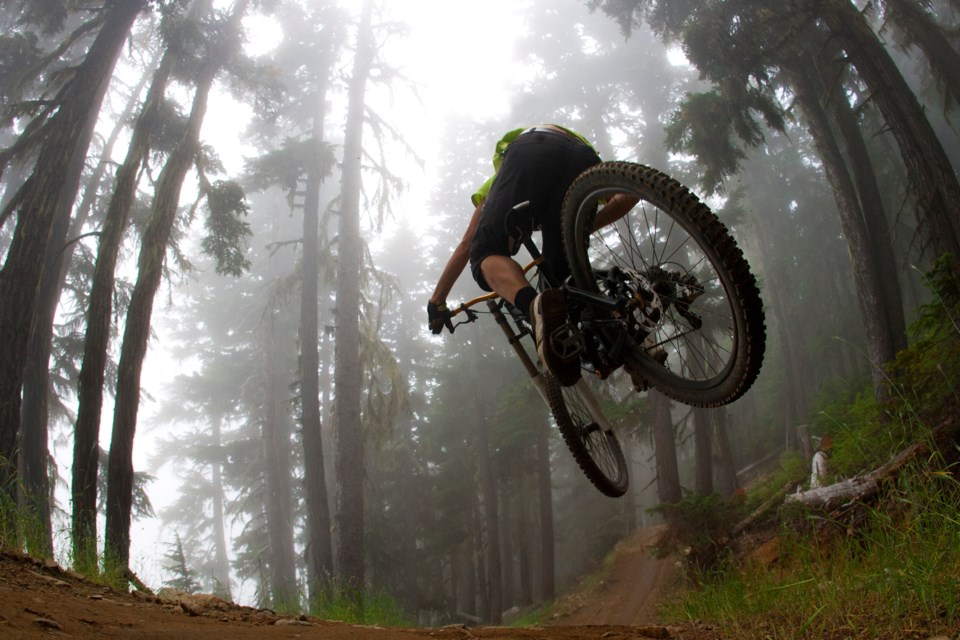“One way out.”
-Andor, Season One
What works well for a prison break, in a loose allegory for our increasingly fascistic society, also works decently well for mountain biking—for there often is no other way out, or down, than the fall line on a singletrack trail.
Which is why one of the most terrifying—and bone-breaking—things to run into on a trail is someone, or something, else.
OK, so it’s a reach, but bear with me. Why? Because bears, brawn and bikes don’t mix.
Whether it be skidding into a hulking mass of brown bear, a wayward hiker lost in a daydream—or heaven forbid, a furry, four-pawed friend happily bounding along, oblivious to the carnage of metal, blood, and bone about to explode all around them—the end result is going to be ugly.
Which brings me to this column’s theme: mountain-biking trail etiquette.
First, a thank you to all awesome friends of the four-pawed who keep their canines leashed. You know who you are. I see you. We smile. Life is good.
Yes, this back page has seen numerous columns devoted to discussions about dogs. My point here though is not just trail dogs. It’s people in general, acting with too much brawn, not enough brains.
I can easily relate a near-crash when whipping around the final corners of the freshly buffed Roam in the Loam, only to screech to a sudden, scree-spraying halt, right before a dazed group of evident tourists in search of a hike.
“Do not keep walking up here!” I cried, as they looked at me in some shock. I was waving my arms about like a semaphore gone berserk. “This is a downhill mountain bike trail! We be whipping down with more balls than brakes!”
To be fair, it’s all a bit confusing. The singletrack trails in our valley have their share of local joggers and dog-walkers. But a mountain bike trail is just that: built for use by mountain bikers, and not spandexed joggers, stoned dogwalkers, or speaker-sporting hikers. Even if you hop out of the way, the distracting presence of a bipedal body can be enough to throw off a biker, particularly a beginner.
Indeed, one of the first things you learn in mountain biking, like any gravity sport, is “look where you want to go.” And so if one is pulled off-course by something or someone else in your vision, it can be enough to send you flying.
The consequences can be severe. Speaking of brainlessness, I once fractured my right wrist on the relatively benign, all-Blue trail network of Upper Zappas. Zipping along, showing a new friend the lovely, traversing trail, I was happily yammering away, glancing back and talking about this and that, until a wayward toe struck a stump, and next thing you know, I was arms wrapped around a tree. My wrist, for the second time, let loose a snap.
Of course, this was my own damn fault. But it taught me the need to maintain absolute focus when on two wheels, even on easier terrain.
Running into bears, of course, or any other wildlife, is entirely a hazard of our sport. It is hardly their fault silly, hairless humans decide to dig up metals, shape them into wheels, and hurtle themselves down into the dirt.
Bears will often eye us with a quizzical look that would be purely comedic were it not for their notorious unpredictability—a bit like a lumbering and moody teenager who could either ignore you entirely or lash out with sudden rage.
And I feel for the bears.
When guiding a mountain bike group last year, I witnessed a bear charge right in front of my bike toward a tree. As the rest of the group descended pell-mell behind me, we tried to get the bear out of the way so we could exit the forest. We did “all the right things”: yelling, banging on wood, acting like utter fools, etc.
Only after about 10 minutes of ridiculous shouting did we realize the bear was a mama, guarding two cute cubs who had run up the tree in pure terror. The bear mama was being all nice about it, too—instead of charging us and ripping our tender flesh limb-from-limb, she kept growling and let us know she wasn’t movin’. Needless to say, we found a different way down.
But then there’s our other friends we need to discuss, the ones at times more brawn than brain—the humans who believe the rules around unleashed dogs don’t apply to them.
I recently had words with a bearded specimen who thought it alright to completely ignore Whistler Blackcomb’s no-dog policy on their trails. He claimed he “hadn’t seen the sign.” I told him I had. It didn’t matter to him. He kept going, unleashed dog in tow. That’s called wilful ignorance.
Or the group that thought it alright to bring an unleashed and untrained dog into Cut Yer Bars, only to have it chase a peaceful, grazing bear—and a young one, too—as their owners lamely yelled, “Come back! Come back! Noooo!”
So let us all review Rule No. 8 of Bear Smart (incant with candle if need be): “Keep dogs on a leash and under control. Dogs may be helpful in detecting bears, but they may also agitate them and create a conflict situation—sometimes returning to their humans with the bear in pursuit.”
In such circumstances, know that you are mostly risking your dog’s life. You are definitely making the entire situation worse—far from truly scaring away the bear, it could result in a really pissed beast baring teeth and claws, coming full speed for your trail nuts.
Of course, if you don’t care, well I guess I could say be my guest, were it not for the fact that you are creating a bad situation for everyone around. And the end result, as we saw recently in April with yet another shooting by a Conservation Officer, could be a dead bear.
And possibly a dead mama bear, too—leaving orphaned cubs.
And that’s some bad karma.
So let’s keep those trails clear of what we alone can control.
Respect the rules, respect wildlife, be aware around bears, and of course, have fun risking it all, balls out, brawn and all, because that’s why we’re here—to keep Whistler wild.
Dr. tobias c. van Veen taught critical humanities and social sciences at Quest University (RIP).




